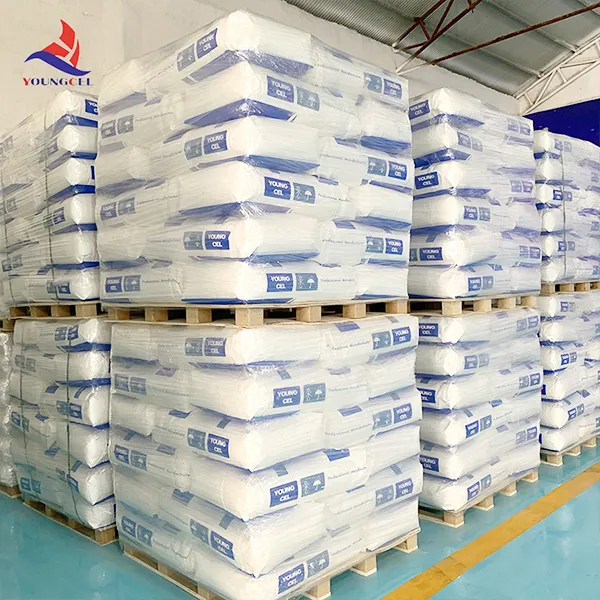The Versatile World of Cellulose Polymer Nature's Gift to Innovation
Cellulose, a complex carbohydrate, is the most abundant organic polymer on Earth, primarily found in the cell walls of plants. Its structural integrity and resistance to degradation make it a critical component of plant life. However, its significance extends far beyond the realms of botany. Cellulose polymers have garnered immense attention in various industries, from food and pharmaceuticals to textiles and biofuels. This article explores the properties, applications, and innovative potential of cellulose polymers.
Understanding Cellulose Polymer
At its core, cellulose is a long-chain polymer made up of glucose units linked by β-1,4-glycosidic bonds. This unique structure imparts strength and rigidity, making cellulose an essential building block for plants. When we refer to cellulose polymers, we often discuss various derivatives and modifications of cellulose designed to suit specific applications. Common derivatives include carboxymethyl cellulose (CMC), hydroxypropyl cellulose (HPC), and cellulose acetate, each possessing unique properties that enhance their functionality.
Properties of Cellulose Polymers
Cellulose polymers exhibit a range of favorable properties, making them suitable for diverse applications. Firstly, they are biodegradable, aligning with the growing demand for environmentally friendly materials. This characteristic is particularly important in a world increasingly concerned about plastic pollution and sustainability.
Furthermore, cellulose polymers possess excellent film-forming capabilities, allowing them to create transparent and flexible films. Their high tensile strength and moisture-retention qualities also contribute to their efficacy in various applications. Additionally, they have good biocompatibility, making them ideal candidates for use in medical and pharmaceutical products.
Applications Across Industries
1. Textiles and Fashion In the textile industry, cellulose fibers, such as cotton and rayon, are predominant. Cellulose polymers can also be used to create innovative fibers with unique properties, like moisture-wicking and anti-bacterial qualities, leading to advancements in performance wear and comfortable casual clothing.
'cellulose polymer'

2. Food Industry Cellulose polymers like CMC are widely used as food additives. They act as thickening agents, emulsifiers, and stabilizers, enhancing the texture and consistency of products like ice cream and salad dressings. Their low-calorie content and non-allergenic nature make them preferable alternatives to synthetic additives.
3. Pharmaceuticals In the pharmaceutical sector, cellulose polymers serve as excipients and drug delivery agents. Their ability to form gels and controlled-release formulations makes them essential in the development of sustained-release medications. Furthermore, cellulose derivatives are used in tablets and capsules, aiding in their formulation and stability.
4. Bioplastics and Biofuels With the rise of bioenergy, cellulose is gaining attention as a feedstock for bioplastics and biofuels. The chemical conversion of cellulose into various biofuels, such as ethanol, has the potential to reduce dependence on fossil fuels while minimizing carbon footprints. Researchers are continuously exploring ways to enhance the efficiency of cellulose conversion processes.
5. Cosmetics and Personal Care Cellulose polymers are also used in the cosmetics industry for their thickening and emulsifying properties. They can be found in lotions, creams, and shampoos, contributing to improved texture and performance while ensuring a pleasant user experience.
The Future of Cellulose Polymers
The versatility of cellulose polymers has positioned them as a focal point in ongoing research and development initiatives. As sustainability becomes increasingly important, scientists are exploring novel ways to harness this natural polymer. Innovations include developing advanced materials for medical applications, sustainable packaging solutions, and eco-friendly textiles.
Moreover, the rise of synthetic biology opens up avenues for genetically engineered organisms to produce cellulose more efficiently, which could revolutionize production methods and lower costs.
Conclusion
Cellulose polymers represent a remarkable intersection of nature and technology, offering a wide array of applications that cater to our modern needs. As industries strive towards sustainability, these natural polymers will play a pivotal role in creating innovative solutions, improving product performance, and contributing to a greener future. With ongoing research and development, the potential of cellulose polymers seems boundless, promising exciting advancements in the years to come.
-
Rdp Powder: Key Considerations for Wholesalers in the Building Materials IndustryNewsJul.08,2025
-
Key Considerations for Wholesalers: Navigating the World of Hpmc - Based ProductsNewsJul.08,2025
-
Hpmc Detergent: Key Considerations for WholesalersNewsJul.08,2025
-
Key Considerations for Wholesalers: China Hpmc For Tile Adhesive, Coating Additives, Concrete Additives, and MoreNewsJul.08,2025
-
Crucial Considerations for Wholesalers: Navigating the World of Construction MaterialsNewsJul.08,2025
-
Key Considerations for Wholesalers Sourcing Additive For Cement, Additive For Concrete, Additive For Putty from Additive Manufacturer Shijiazhuang Gaocheng District Yongfeng Cellulose Co., Ltd.NewsJul.08,2025




